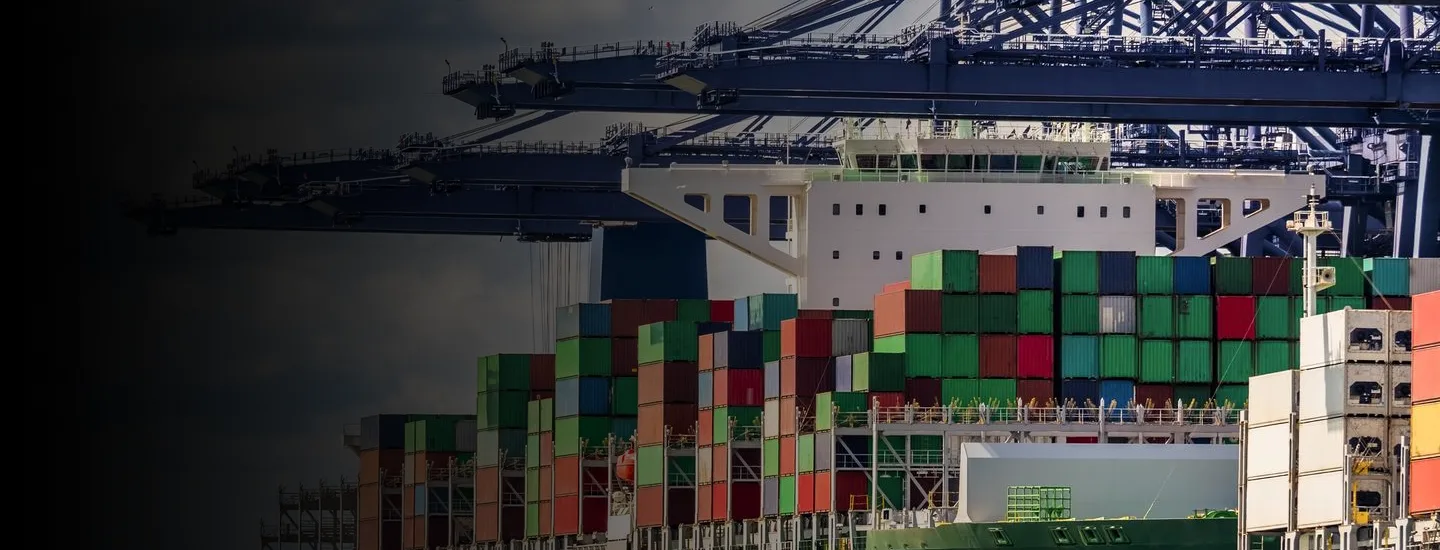Brian Nemeth
Update on 5.12.2025: Following two days of negotiations in Geneva, the U.S. and China agreed to a significant de-escalation in their trade dispute. The Trump administration will reduce tariffs on Chinese imports from 145% to 30%, while China will lower its counter tariffs on U.S. goods from 125% to 10%. Both sides hailed the outcome, with U.S. officials calling it a “historic trade win.” Further talks are expected in the coming weeks to work toward a more comprehensive agreement.
The global supply chain is entering a new era of turbulence, triggered by the United States' sweeping new tariffs affecting nearly 90 countries. As trade partners respond with retaliatory measures, businesses across Europe, the Middle East, and Africa (EMEA) are facing mounting pressure to adapt. From air and ocean freight disruptions to rising inland transport costs and shifts in sourcing strategy, the ripple effects are far-reaching. This article explores how the evolving tariff landscape is reshaping logistics flows, pressuring fulfillment infrastructure, and prompting companies to regionalize their operations—all in an effort to mitigate risk and build resilience amid growing economic uncertainty.
America’s tariff offensive: Background and global ripples
The U.S. has imposed tariffs on imports from nearly 90 countries, targeting key partners like China, the EU, and Canada. The proposed U.S. tariff on EU goods alone threatens €380 billion in exports—about 70% of Europe’s total U.S.-bound trade—translating to over €80 billion in duties, a significant jump from today’s €7 billion.
In retaliation, the EU enacted counter-tariffs aimed at shielding its domestic industries. A 90-day suspension by both sides briefly cooled tensions, but the economic fallout was immediate—rattling markets and depressing consumer confidence.
The EU is playing the long game. Its phased, targeted tariff strategy—such as 25% duties on steel and aluminum—seeks to maximize leverage without escalating into a full-blown trade war. The bloc is also preparing the Anti-Coercion Instrument (ACI), which could hit not only U.S. goods but also services and investments as well.
Across the EMEA region, countries are diversifying trade partners and reshaping supply chains to buffer against future U.S. shocks. Negotiations remain on the table. The EU has signaled its willingness to strike a deal, offering concessions like increased LNG imports and tariff reductions on select items. However, until resolution is in sight, market volatility will persist—and so will the risk of inflation or recession.
Cleared for turbulence: Europe’s air freight impact under tariff pressure
Global air freight demand will see temporary rate increases as shippers rush to stock local warehouses ahead of full tariff implementation. However, rates are likely to drop in the mid-term due to overcapacity.
The tightening of U.S. trade rules on e-commerce shipments is likely to have significant knock-on effects for the European air freight sector. As U.S.-bound volumes, particularly from China, decline sharply due to the elimination of the de minimis exemption and the introduction of tariffs of up to 145%, global freighter capacity previously dedicated to Asia-U.S. routes may shift toward European destinations. In addition, the European Commission is considering the elimination of its own de minimis threshold for low-value consignments. Given the EU Commission’s estimate that 4.6 billion packages, each with a declared value under 150 euros, entered the European Union last year, the push for new legislation is intensifying. Should EU e-commerce demand weaken significantly, overcapacity is imminent, since several carriers currently operate multiple charters per week for companies like Temu and SHEIN. Cargo carriers may respond by retiring older, fuel-inefficient aircraft earlier than initially planned to reduce operating costs, slightly decreasing market capacity. However, a supply-demand imbalance is likely to persist for the foreseeable future.
As air freight becomes less viable for direct-to-consumer cross-border shipments, European stakeholders may be forced to accelerate investments in localized warehousing and B2B2C infrastructure. This shift will reshape fulfilment strategies and network planning across Europe, significantly increasing the demand for intra-European transportation.

Baltic Exchange Airfreight Index as of 05/06/2025:
Navigating rough waters: How U.S. trade policies are shaping Europe's maritime flows
U.S. tariffs introduced under the Trump administration continue to disrupt global trade, indirectly impacting the EU, despite the steepest volume declines being on trans-Pacific lanes. As U.S. import demand weakens, global logistics planning becomes increasingly volatile, affecting EMEA stakeholders.
According to the Global Port Tracker (NRF & Hackett Associates), a sharp decline in U.S. freight volumes is expected in the coming months. While primarily affecting Asia–U.S. lanes, reduced U.S. demand will likely depress European exports too, leading to lower vessel utilization, more schedule changes, and increased pricing pressure on transatlantic trade.
While Europe–U.S. East and Gulf Coast routes have seen limited blank sailings so far—only several thousand TEUs are set to be withdrawn in May—carriers are already boosting capacity. This anticipates potential frontloading by European exporters seeking to mitigate further tariff hikes or disruptions.
As of May 08, 2025, ocean freight rates show broader declines amid trade tensions. Shanghai–Rotterdam rates fell 7%, and Shanghai–Genoa dropped 4%. Transatlantic rates also declined, with both New York–Rotterdam and Rotterdam–New York decreasing by 3%. Drewry expects rates to be less volatile in the coming week as carriers are reorganising their capacity to reflect a lower volume of cargo bookings from China.

Looking ahead, tariff uncertainty is prompting shippers to reassess U.S.-bound volumes, delaying any real market recovery until 2026. For European logistics teams, this means revising forecasts, adjusting strategies, and bracing for prolonged rate softness.
On the move: How tariff pressures are reshaping Europe’s inland logistics
The announcement of U.S. tariff threats has significantly impacted EMEA supply chains. An estimated 57 percent of Europe’s top shippers expedited inland hauls to clear inventories ahead of higher duties.
Eurostat reports that EU exports to the U.S. rose 22.4% year-on-year in February, prompting a surge in road-transport demand. Some analysts predict that, after a 3.3% real-terms drop in 2023, road-freight volumes may rebound in 2025, driven by tariff spikes.
With cargo stalled before quaysides, carriers have raised domestic rates: IRU’s Q4 2024 benchmark shows contract indices up 2.8 points to 128.9 and spot rates up 0.5 to 123.9, despite easing ocean-freight costs. Surveys suggest nearly half of haulers cannot expand due to hundreds of thousands of driver vacancies, with relief unlikely until recruitment picks up.
Amid these tariff hikes and the rollback of the de minimis exemption, many Chinese e-commerce exporters have reoriented their logistics strategies toward Europe, accelerating demand for bonded warehousing to serve EU markets. At the same time, European exporters racing to beat U.S. tariff deadlines have caused short-term congestion at key ports and logistics hubs, driving vacancy rates below 5% in the continent’s top 30 logistics markets.
Looking ahead, many expect that once Q2 front-loading subsides, cargo volumes may moderate, though capacity constraints are still likely to persist. Businesses must weigh excess inventory and premium storage costs against the risk of sudden duty hikes.
Reshaping supply chains: EMEA's regionalization response to tariff risks
The threat and partial roll-out of U.S. tariffs has spurred a major reconfiguration of EMEA logistics networks, with many companies regionalizing production and distribution to offset future duty risks. Some trends include sourcing from new locations such as Turkey, Morocco, and Eastern Europe, which would shorten transport distances, trim trans-Atlantic exposure, and mitigate levy risks. Some exporters have also adopted ‘Plan B’ measures to ship to Canada and Mexico instead of the United States to insulate operations from tariff shocks.
Protecting supply chains: How EU importers can navigate rising tariff risks
As trade tensions between the United States and the European Union face ongoing uncertainties, EU shippers must take proactive measures to protect their operations and ensure the resilience of their supply chains. The first priority should be a thorough assessment of exposure—identifying which U.S. imports are likely to be affected by potential retaliatory tariffs and modeling the potential financial and operational impacts. This analysis should encompass not only direct imports but also components sourced indirectly through global supply chains.
To mitigate risk, importers should look to diversify their supplier base by exploring alternatives in non-U.S. regions and adopting dual sourcing strategies. Regionalizing parts of the supply chain within the EU could further enhance stability, reducing reliance on external markets and minimizing vulnerability to cross-border disruptions.
EU importers should also consider front-loading key shipments to mitigate the impact of potential retaliatory U.S. tariffs. This strategy can help avoid cost increases and supply disruptions, particularly for high-demand or tariff-sensitive goods. It is crucial to focus on products with steady turnover while ensuring adequate storage capacity. When used strategically, front-loading can serve as an effective short-term hedge against trade risk.
Finally, this situation presents an opportunity for importers to reassess their long-term strategies in the face of a potentially more protectionist global landscape. Building flexibility, sustainability, and resilience into supply chain operations now will offer significant benefits if trade frictions continue or escalate.

